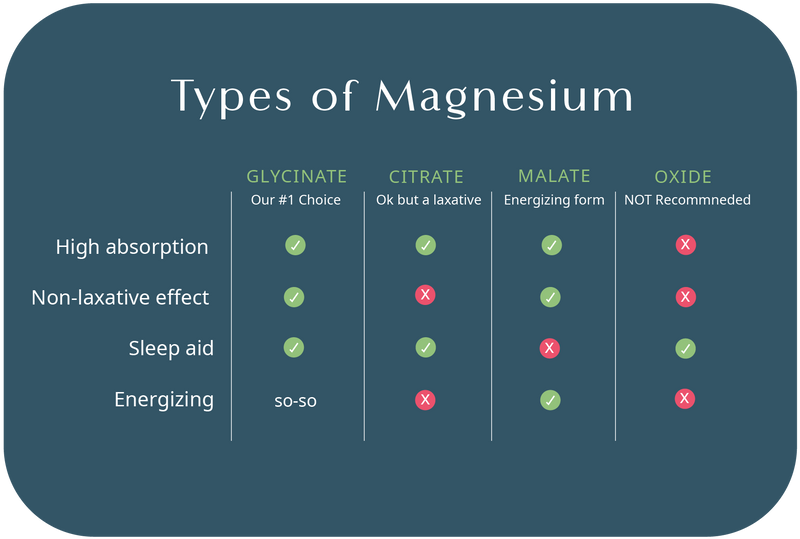How magnesium can help hormones
Estrogen Balance - Supports Phase II of Complete Estrogen Detoxification by eliminating "dirty" estrogens
Thyroid Function - Helps convert the less active T4 thyroid hormone to the bio-active T3
Adrenaline and Cortisol - Helps reduce over-reactivity in your Hypothalamic-Pituitary-Adrenal (HPA) axis, keeping you calm and less stressed
Blood Sugar - Helps stabilize blood sugars, leading to fewer cravings and easier maintenance of a healthy weight
Testosterone and Progesterone - Plays a role in pivotol processes that allow your body to produce sex hormones
DHEA and HGH - Supports better sleep to allow your body to efficiently produce these anabolic hormones and repair cellular damage
Serotonin Levels - Helps convert tryptophan (an amino acid) into the important mood-boosting hormone serotonin
How magnesium may support overall health
Constipation - Helps with bowel movement and complete elimination
Detoxification - Helps eliminate toxins and supports a healthy liver function
Bone Health - Partners with calcium in maintaining bone health
Digestion and Elimination - Helps to restore healthy magnesium balance and elimination
Cardiovascular Health - Supports muscle relaxation and function, which is vital to cardiovascular health. Also supports blood vessel function and heart health
Sleep - Helps naturally support falling and staying asleep
Relaxation - Helps muscles to relax, promotes a sense of calm by activating the parasympathetic nervous system (rest-and-relax responses)
Kidney Health - Prevents unnatural accumulations of calcium in kidneys

Which form of magnesium is right for you?
Magnesium Replenish is made from magnesium glycinate, the best absorbed form of magnesium - where a magnesium ion is bound between two glycine amino acids, forming a very stable chelate.
This form of magnesium helps you replenish magnesium deficiency very quickly. It eliminates the possibility of loose stools or upset stomach that may occur with other magnesium supplementation.
Symptoms of low magnesium may include:
- Painful periods and PMS
- Painful breasts, lumps
- Hot flashes
- Poor sleep, insomnia, waking
- Muscle pain and tension
- Craving chocolate
- Chronic constipation
- Poor detoxification ability
- Irregular heart beat
- Headaches
- Depression
- Anxiety
- Quick exhaustion during exercise
This Product Works Best With
 2 Magnesium Replenish capsules (300 mg)
2 Magnesium Replenish capsules (300 mg) 1 cup almonds
1 cup almonds 1/2 cup cacao
1/2 cup cacao
Recommended use: Take 2 capsules per day, or as directed by your heath care practitioner. Magnesium Replenish can be taken as part of the Magnesium Rotation Method to balance hormones and restore optimal health.
Magnesium (as Magnesium Bisglycinate Chelate and Magnesium Oxide)
Other Ingredients: Hypromellose (Capsule), Vegetable Stearate.
Quality Check
- be made in a GMP-certified facility
- be free of gluten, dairy, additives and colorants
- be 3rd party tested for efficacy
Reviews
Frequently Asked Questions
Magnesium replenish is recommended for use in the evening to support digestion and gentle relaxation. We carry three other forms of magnesium in the Wellena shop:
- Mag Energy (magnesium malate): This is a form of magnesium that many women find energizing, and is best taken in the morning with breakfast.
- Quick Magnesium (magnesium chloride): This is a topical form of magnesium that soothes muscles and supports healthy sleep, and is best taken before bed.
- Magnesium Citrate: This form of magnesium is recommended for those with chronic constipation or while traveling.
All four types of magnesium can be taken together in the Magnesium Rotation Kit.
To know if you need a higher dose, try the “bowel tolerance test” described below. This means you go up in doses every two days until your stool becomes loose.
Some women are so depleted (stress and sugar are common magnesium robbers) that they need as much 1,200 mg per day to replenish their reserves. Once you get a loose stool, back off to a lower dose.
Here is an example:
Day 1: 300 mg per day; regular stool or constipation
Day 2: 300 mg per day; regular stool or constipation
Day 3: 600 mg per day (300 mg in the morning and 300 mg at night); regular stool or constipation
Day 4: 600 mg per day (300 mg in the morning and 300 mg at night); regular stool or constipation
Day 5: 900 mg per day (600 mg in the morning and 300 mg at night); regular stool or constipation
Day 6: 900 mg per day (600 mg in the morning and 300 mg at night); loose stool
Day 7: Back off to 600 mg per day (300 mg in the morning and 300 mg at night) to go back to regular stool
Continue taking 600 mg per day until you develop loose stool, then back off again. If not, stay on this dose.
To settle on the best dose of magnesium, you need to listen to what feels right for your body. If you overdo it, you will experience loose stool or intestinal rumbling and then you will know to reduce your daily intake.
Beckstrand, Renea L. Beneficial Effects of Magnesium Supplementation. Journal of Evidence-Based Integrative Medicine. 2011.
National Institutes of Health Office of Dietary Supplements. Magnesium: Fact Sheet for Health Professionals. U.S. Department of Health & Human Services website. Updated online October 11, 2019.
Tammaro, A. Magnesium stearate: an underestimated allergen. Journal of biological regulators and homeostatic agents. Oct-Dec, 2012.
Patel, Kamal. Magnesium. Examine.com. Updated November 15, 2019.
Dean, Carolyn. The Magnesium Miracle, Ballantine Books, December 26, 2006.
Last, Walter. Magnesium Chloride for Health and Rejuvenation. Nexus Magazine. Oct-Nov, 2008.
Engen, Deborah J. et al. Effects of transdermal magnesium chloride on quality of life for patients with fibromyalgia: a feasibility study. Journal of Integrative Medicine. September, 2015.
DO YOU SHIP TO CANADA?
Yes, we now do! If you’re in Canada, you should be automatically directed to our Wellena Canada store. wellena.com/en-ca
DO YOU SHIP TO THE UK, AUSTRALIA OR OTHER COUNTRIES?
Unfortunately, at this point we only ship to the United States. This is due to the ever-evolving international laws surrounding supplements.
There are forwarding companies like MyUS.com, that will forward orders to you in your country for a fee.
In this case, it is the customer’s responsibility to find out in advance if the supplement in question is legal in their country.
WHY DOES SHIPPING COST $11.45?
For small businesses like ours, the shipping fee covers the very real costs of getting your order to you: shipping, handling, packaging, warehousing, insurances, and fairly compensating all the people involved along the way. We do our best to keep this shipping cost as low as possible, and offer FREE shipping for orders $97 and above.
WHY DOES MY SUBSCRIPTION ORDER INCLUDE $11.45 SHIPPING?
If you set up a subscription order and notice that you are being charged shipping, it could be due to one of these reasons:
1. Your order value is under $97
2. Your initial order qualifies for free shipping, but the order frequency on your subscriptions is different ( 1 product is set to ship every month, the other is set to ship every 2 months).
*The system automatically splits this kind of order into 2 separate shipments.
In this case it is more economical to set up one subscription every 2 months, and to increase your quantity to 2 units of the supplement that you consume monthly.
For example: 2 Vitamin B6 + 1 Essential Omegas every 2 months = free shipping.
Please email us at support@hormonesbalance.com if you would like some help managing your subscriptions.
Frequently Asked Questions
Magnesium replenish is recommended for use in the evening to support digestion and gentle relaxation. We carry three other forms of magnesium in the Wellena shop:
- Mag Energy (magnesium malate): This is a form of magnesium that many women find energizing, and is best taken in the morning with breakfast.
- Quick Magnesium (magnesium chloride): This is a topical form of magnesium that soothes muscles and supports healthy sleep, and is best taken before bed.
- Magnesium Citrate: This form of magnesium is recommended for those with chronic constipation or while traveling.
All four types of magnesium can be taken together in the Magnesium Rotation Kit.
To know if you need a higher dose, try the “bowel tolerance test” described below. This means you go up in doses every two days until your stool becomes loose.
Some women are so depleted (stress and sugar are common magnesium robbers) that they need as much 1,200 mg per day to replenish their reserves. Once you get a loose stool, back off to a lower dose.
Here is an example:
Day 1: 300 mg per day; regular stool or constipation
Day 2: 300 mg per day; regular stool or constipation
Day 3: 600 mg per day (300 mg in the morning and 300 mg at night); regular stool or constipation
Day 4: 600 mg per day (300 mg in the morning and 300 mg at night); regular stool or constipation
Day 5: 900 mg per day (600 mg in the morning and 300 mg at night); regular stool or constipation
Day 6: 900 mg per day (600 mg in the morning and 300 mg at night); loose stool
Day 7: Back off to 600 mg per day (300 mg in the morning and 300 mg at night) to go back to regular stool
Continue taking 600 mg per day until you develop loose stool, then back off again. If not, stay on this dose.
To settle on the best dose of magnesium, you need to listen to what feels right for your body. If you overdo it, you will experience loose stool or intestinal rumbling and then you will know to reduce your daily intake.
How we make things to be delivered directly to you
Science. Research. Facts.
All our products are rooted in science. No BS, just clean and honest ingredients that work.
We don’t greenwash. Ever.
No greenwashing means that we don't use misleading marketing to make our products seem more green or eco-friendly. Our products really are as natural as it gets.
If it’s not squeaky clean, it’s out.
We work hard to bring you products that are safe and effective. The top offenders we never invite to the party: GMOs, hormone disruptors, gluten, soy, and dairy.
Rigorously tested
Our manufacturing facilities are GMP compliant, which means every product is carefully tested. Our products are proudly made in the US and Canada.
Time-honored traditions
Many of our products use botanicals inspired by ancient herbal traditions from around the world.
1+1 = 5
Our ingredients work synergistically, amplifying each other. We transform them into meaningful products that make a difference for your body and spirit.
































